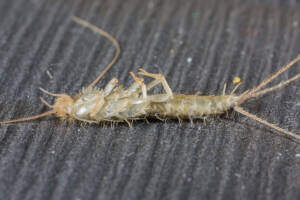Silverfish in My Attic
Silverfish and Firebrats

Silverfish
Nothing more disturbing is the sight of a silverfish in my closet. Will they eat or destroy my wardrobe? Will they stain my walls? Do they bite? These are questions homeowners ask all the time. However, there is a way to beat these little insects. Read on…
Silverfish and firebrats prefer dark places. They are rarely seen in the day and when they are, it is because they must have been disturbed. When these insects are spotted on the ceiling, then it means they must be coming from the attic of the structure. As the weather warms and the temperature in the attic increases, there will be increased activity and sightings of the silverfish. Sightings on the wall or ceiling mean that there should be treatment in the attic.
Both the silverfish and firebrat have quick movements where they go in short intervals then quickly taking off with quick movements. They are good climbers on walls however, not on smooth surfaces that is vertical. Because of the inability of silverfish to climb smooth surfaces is why you see them trapped in bathtubs, sinks and glass trays.
The silverfish can reach 1/4 to 1/2 inch long in growth. The young are considerably smaller.
Silverfish and firebrats have silver and gray colored body that is close to a pearl color. If you look closely at the silverfish and firebrat, you will notice that the firebrat has mottled appearance. The bodies of the two are thick at the front and slender in the back, much like a cone. The tail tends to have a pointed look with two slender antennae in front and three long, thin appendages in back.
Control
The firebrat thrives on hot conditions with temperatures between 90 to 110 degrees. It takes only three months for this insect to travel from egg to full grown. When temperatures reach the optimum range, they will lay their eggs in cracks or small openings, particular along the baseboards and quarter rounds of rooms.
Chemical control of silverfish and firebrats is similar to that employed for cockroaches. Treatment should be thorough and cover cracks and crevices. In warm basements all pipes should be treated especially if they are warm. All areas that are warm should be serviced. Dust is one of the best treatments for silverfish. Use as necessary to maintain control. Dust is effective; however, moisture can affect the dust. Attics are the most important place for treating for silverfish, as it is the warmest portion of the house.
Prevention
The best way to prevent silverfish is to change the lighting and temperature. We call that biological control. Changing the temperature can cause the silverfish to die or move to another area. If that happens then it may be to your advantage…you may be able to reach them easily. A piece of furniture against a warmer part of the house may provide a hiding place for firebrats or silverfish. You might want to move furniture from the wall to another place that is cooler were the silverfish will not survive as well.
Remember, modifying temperature will be the best effect for silverfish and firebrats. They thrive at high temperatures and can reproduce at temperatures set at 90 to 110. As the temperatures drop below the desired setting, the firebrats and silverfish will move and die in undesirable locations.
If you are at ends with silverfish, Call Truly Green Pest Control for immediate relief from these destructive little insects.
Contact Us Today!